| **Steps** | **Clarification** | **Responsibilities** |
| **Step 1:** Associate Eskimi DSP and Eskimi Media Partner with the IAS account. \*This step needs to be completed once for each agency's IAS account. If the account was already associated before, move to step 2. | With Eskimi now integrated into IAS as a DSP, clients can easily request association with their IAS account for streamlined tracking and optimization. By linking Eskimi DSP and Eskimi media partner with the agency's IAS account, all future tags created for Eskimi DSP will automatically include DSP internal macros. This facilitates tracking metrics per custom segments provided by the DSP, enhancing campaign optimization. To initiate the association process, clients can reach out to[ IAS support](https://manual.eskimi.com/helpcenter.integralads.com) using the following request: **"Hello,** **We would like to associate Eskimi DSP (ID: 77) and Eskimi media partner (ID: 9688) with our team/account."** | Client / Agency |
| **Step 2:** Create IAS Tag \*Ensure that the selected type of tag aligns with campaign goals and supports the measurement of KPIs. For further details on tags, refer to the **[provided article](https://manual.eskimi.com/books/3rd-party-tracking/page/ias-video-and-display-trackers-glossary)**. | **Scenario 1:** Tags that do NOT require Eskimi AdServing or future wrapping (display monitoring tags, impression 1x1 pixel tracker video) - Follow the [Tag Manager user Guide](https://helpcenter.integralads.com/article/tag-manager-guide) to prepare the tags. **Scenario 2:** Video tag that requires Eskimi AdServing and future wrapping with IAS tags (Wrapped Video) - Provide mp4 file to Eskimi AdOps at adops@eskimi.com. - Eskimi AdOps Team will upload the mp4 file to the Ad Server. - Eskimi AdOps Team will provide the VAST URI back to you. - Agency utilise the provided VAST URI to prepare wrapped video tags following the - [Tag Manager - User Guide.](https://helpcenter.integralads.com/article/tag-manager-guide) | Client / Agency |
| **Step 3:** Provide information about Brand's KPIs for IAS and Brand requirements | To ensure that the campaign effectively meets its KPIs, alignment on KPIs and requirements is crucial. Therefore, the agency/client is responsible for providing such details, including brand safety guidelines and campaign IAS KPIs, to the Ad Ops Team in the email thread together with [other campaign details.](https://manual.eskimi.com/link/16#bkmrk-campaign-requirement) | Client / Agency |
| **Step 4:** Provide IAS trackers to Eskimi AdOps | The agency/client is responsible for providing accurate IAS trackers, ensuring their reliability and relevance for campaign KPIs measurement. | Client / Agency |
| **Step 5:** Correct implementation of the tag | Eskimi AdOps is responsible for the correct implementation of IAS trackers, maintaining consistency across diverse campaigns | Eskimi DSP AdOps |
| **Step 6:** Setup of daily auto-reporting | The agency/client will receive campaign data in IAS reports within 48 hours from the campaign start time, at which point it is possible to export the IAS report. It is the agency's responsibility to either set up auto-reporting or provide consistent reporting containing mandatory information for campaign optimization to the Eskimi AdOps team at adops@eskimi.com. The provided report should include data for the total campaign per day, as well as data per apps/sites or placement\_id macro. For more detailed report information, please refer to the instructions provided in [this article.](https://manual.eskimi.com/link/439#bkmrk-page-title) | Client / Agency |
| **Step 7:** Check reports daily and optimise for IAS KPIs | Eskimi offers the capability to optimise campaigns based on client KPIs using insights from IAS reports. Here's an outline of the optimisation process and requirements: 1. The agency receives IAS reports once tags are implemented and the campaign has been live for more than 48 hours. 2. The agency shares the report with required segments with Eskimi AdOps. 3. Eskimi proceeds to optimise the campaign by either excluding low-performing segments or including high-performing segments. These segments typically revolve around apps/sites or placement\_id. | Eskimi DSP AdOps |
| **Step 8:** Troubleshoot \*Applied only when there are significant discrepancies between Eskimi DSP vs IAS report. | Upon checking reports and identifying discrepancies, the following actions need to be taken in the established order until the root of the issue is identified: 1. Eskimi AdOps is responsible for checking if the tag was implemented correctly and/or if there's tag duplication. 2. Eskimi AdOps is responsible for exporting the daily campaign report and providing a preview page where tags are firing for future investigation. 3. The Client/Agency is responsible for double-checking and confirming that there were no mistakes in tag creation. 4. The Client/Agency is responsible for contacting IAS support for further investigation | Eskimi DSP AdOps / Client / Agency |
**Disclaimer: Eskimi's Accountability** - Eskimi assumes no responsibility for discrepancies or issues in measurement capabilities found in IAS reports if they originate from areas under the control of the agency/client. While Eskimi may provide support and suggestions in various scenarios, the ultimate responsibility lies with the agency/client based on designated areas of responsibility. Therefore, Eskimi cannot be held liable for compensation related to such circumstances.
--- #### **FAQ** **Does Eskimi support IAS trackers?** Yes. Eskimi supports monitoring pixel trackers, as well as monitoring creative tags. Eskimi also supports blocking tags that prevent showing the ad visuals in forbidden content. **Do you have the ability to optimise the campaign based on viewability?** Yes. We track viewability metrics in our internal reports, and with this data campaigns can be optimised accordingly. However, it's also important for us to receive IAS reports to monitor any discrepancies and optimise the viewability of IAS data, as the measurement technologies are slightly different. **Do you have the ability to optimise the campaign based on brand safety?** Yes. To optimise, we'll need a report from IAS based on which optimisation will be done. Because Eskimi isn't measuring Brand Safety KPIs internally. **How can we track viewability with IAS trackers in banner and video campaigns?** Video IAS measurement - In order to capture Viewability data when running a VAST campaign, each video must be wrapped within an IAS tag. This tag, within IAS, is referred to as Multimedia Tag Monitoring. It's important to note that employing this tracker might result in the exclusion of certain traffic, as only video traffic compatible with VPAID/OMID will qualify for viewability measurement. Display IAS measurement - Viewability data can be gathered by implementing the tracker in the form of a Javascript tag. **How Eskimi can optimise IAS KPIs?** We need daily reports from IAS, based on which we will create a black-list/ white-list and apply them to the campaign as optimisation. [Here](https://manual.eskimi.com/books/3rd-party-tracking/page/ias-report-builder-agency-account) are the instructions about expected segments in the IAS report. # 3rd Party Verification Platforms # Exploring Banner/IBV/Native Integrations within 3rd Party Verification Platforms ##### **Introduction** In the dynamic landscape of digital advertising, where capturing and retaining users' attention is paramount, the role of third-party verification platforms has become increasingly vital. Advertisers and publishers alike have sought ways to ensure the transparency, viewability, and brand s afety of their online campaigns. However, beyond their fundamental functions lies a lesser-known yet innovative aspect that is pois ed to revolutionise the industry - **the integration of creative wrapping**. In this article, we delve into the practical implications how Banners/IBV/Native ads executed through Eskimi should be wrapped into a 3rd party verification platform. --- ##### **Banner, IBV, Native Wrapping Process for Ad Operations Team** 1. Begin by uploading the client's creatives through the creative setup page. 2. Set up a campaign using the newly uploaded creatives. 3. Access the preview page of the campaign. 4. Right-click on the creative and select "Inspect Element", or navigate to the developer's tools. [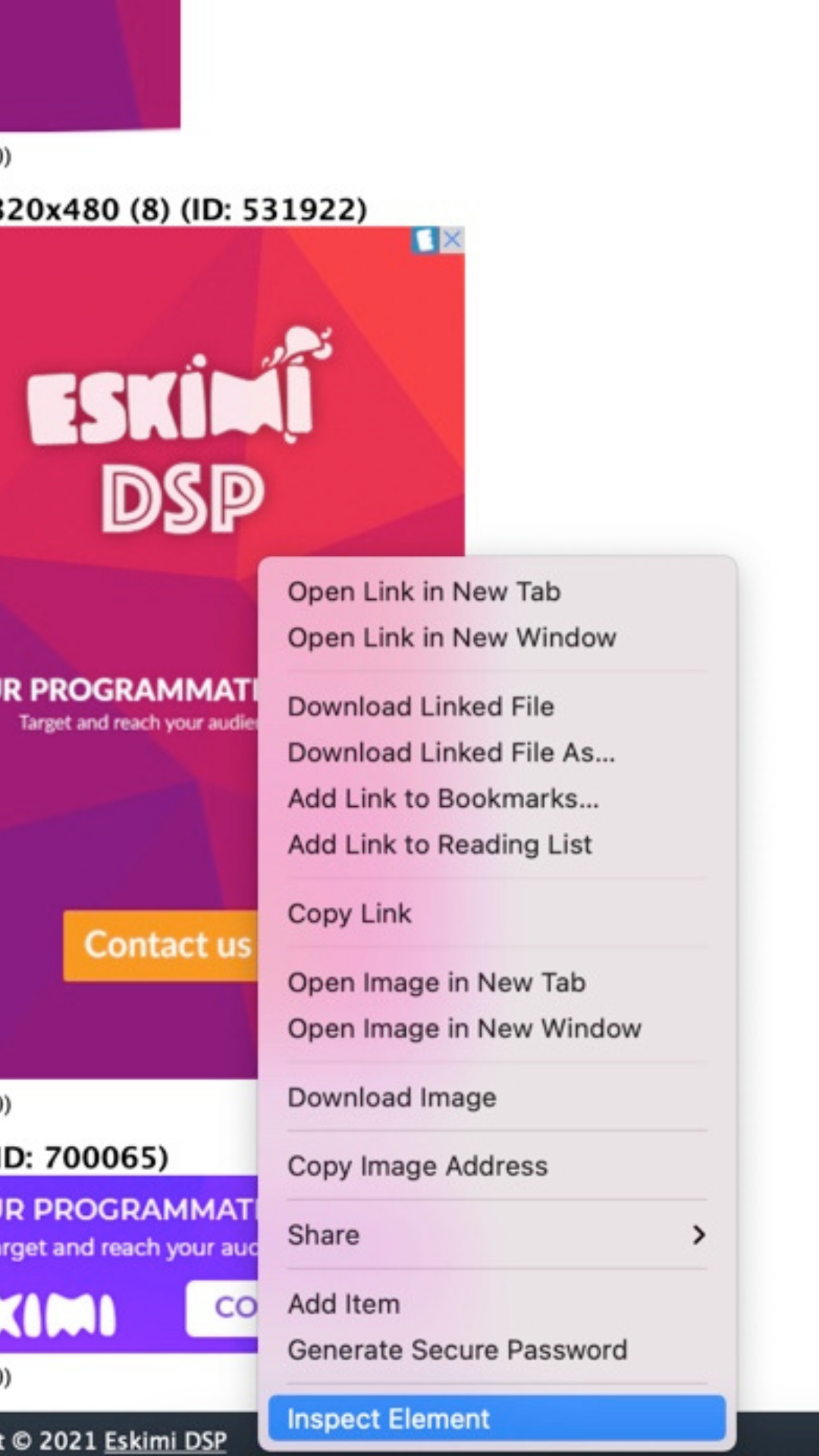](https://manual.eskimi.com/uploads/images/gallery/2021-03/untitled-design-5.png) 5\. Locate the `| **IAS Solution** | **Explanation** | **Requirements** | **Measure Viewability** | **Measure Invisible URLs** | **Measure Impressions** | **Measure Brand Safety** |
| Multimedia Tag Monitoring (Wrapped Video) | Video tracking tag that will work across desktop, CTV, mobile & in-app. Can measure viewability, set to not block | Requires a VPAID or OMID player/publisher support & 3rd party ad serving | Yes | Yes | Yes | Yes |
| Multimedia Tag Blocking (Wrapped Video) | Video tracking tag that will work across desktop, CTV, mobile & in-app. Can measure viewability, set to block | Requires a VPAID or OMID player/publisher support & 3rd party ad serving | Yes | Yes | Yes | Yes |
| Unified Video 1x1 Pixel | Video tracking tag that will work across desktop, CTV, mobile & in-app. Cannot measure viewability or block | Requires a VAST player & 3rd party ad serving | No | No | Yes | Yes |
| **IAS Solution** | **Explanation** | **Measure Viewability** | **Measure Invisible URLs** | **Measure Impressions** | **Measure Brand Safety** |
| Blocking Creative Tag | Display tags with blocking. Requires JS support | Yes | Yes | Yes | Yes |
| Monitoring JS | Display tags without blocking. Requires JS support | Yes | Yes | Yes | Yes |
| Monitoring 1x1 pixel | Display tags without blocking. | No | No | Yes | Yes |
| Term | Definition |
| Total Tracked Ads | The number of ads IAS processed. |
| Eligible Ads For Viewability Measurement | The number of all unblocked ads that are invalid traffic (IVT) free and served in a JavaScript environment where Viewability measurement is possible. |
| Measured Ads | The total number of ads in the campaign with all detected invalid traffic removed, where IAS was able to collect viewability data. In some ad environments, technical limitations can prevent ads from being measured for viewability or audibility by IAS. |
| Measured Rate (out of Ads) | The percentage of Measured Ads out of Eligible Ads for Viewability or Audibility Measurement. |
| Viewable Impressions | The number of unblocked viewable impressions in the campaign with all detected invalid traffic removed, where at least 50% of the ad was in view for 1 continuous second for display (2 continuous seconds for video). |
| Viewable Rate (out of measured ads) | The percentage of Viewable Impressions (at least 1 pixel of the creative rendered on screen; 50% in view for 1 continuous second - display; 2 continuous seconds - video; a 30% or more rule applies to large creatives that are at least 242,500 pixels.) out of unblocked Measured Ads with all detected invalid traffic removed. |
| Eligible Ads for Invalid Traffic Detection | Excludes all ads where signals to make an IVT determination are missing. Note: This metric has been updated to no longer include test impressions, which was previously reported as GIVT and represents a trace amount of overall GIVT impressions. Test impressions will still be included in our calculation for Total Tracked Ads. |
| Eligible Rate For Invalid Traffic Detection | The percentage of Eligible Ads for Invalid Traffic Detection, out of all ads IAS processed (Total Tracked Ads). |
| General Invalid Traffic (GIVT) Ads | Traffic that failed to meet ad quality criteria filtered through and caught by known IP and bot lists (ex: Google web crawlers). |
| General Invalid Traffic (GIVT) Rate | The percentage of ads that IAS detected as GIVT, out of all ads processed by IAS. Traffic that failed to meet ad quality criteria filtered through and caught by known IP and bot lists (ex: google web crawlers). |
| Sophisticated Invalid Traffic (SIVT) Ads | Traffic that failed to meet proprietary and sophisticated invalid traffic detection criteria. Examples of failed traffic can include: hijacked devices, ad tags, or creative; adware; malware; and misappropriated content. |
| Sophisticated Invalid Traffic Rate | Percentage of traffic that failed to meet proprietary and sophisticated invalid traffic detection criteria out of Total Tracked Ads. |
| Bots (SIVT) Ads | The number of ads that IAS detected as bots. A malicious software application that runs automated tasks over the internet, usually to make a profit by falsely mimicking real human activity. |
| Bots (SIVT) Rate | The percentage of ads that IAS detected as bots, out of all ads processed by IAS. A malicious software application that runs automated tasks over the internet, usually to make a profit by falsely mimicking real human activity. |
| Domain Spoofing (SIVT) Ads | Ads that are low quality inventory disguised as high-quality legitimate-sites, or send incorrect referrer information to hide their identity. |
| Domain Spoofing (SIVT) Rate | The percentage of ads that are low quality inventory disguised as high-quality legitimate-sites or send incorrect referrer information to hide their identity, out of all ads processed by IAS. |
| Hidden Ads (SIVT) | The number of ads that IAS detected as Hidden Ads (SIVT). Ads that have no chance of ever being seen by humans. Types of hidden ads include: pixel stuffing, ad stacking, ads clipped by iframes, zero opacity ads, off-page ads, ad truncation, and hidden ads embedded in ads. |
| Hidden Ads (SIVT) Rate | The percentage of ads that IAS detected as Hidden Ads (SIVT), out of all ads processed by IAS. Ads that have no chance of ever being seen by humans. Types of hidden ads include: pixel stuffing, ad stacking, ads clipped by iframes, zero opacity ads, off-page ads, ad truncation, and hidden ads embedded in ads. |
| Reduced Value Inventory (RVI) Ads | Traffic which IAS flagged as being generated in a way counter to the advertiser’s interests. Possible examples include the use of incentivized browsing and "proxy servers". |
| Reduced Value Inventory Rate | The percentage of Reduced Value Inventory (RVI) Ads, out of all ads processed by IAS. |
| Incentivized Browsing (RVI) Ads | The act of interacting with ads for payment or benefits, usually not by an advertiser-targeted audience |
| Incentivized Browsing (RVI) Rate | The percentage of ads that IAS detected as Incentivized Browsing (RVI), out of all ads processed by IAS. The act of generating traffic and/or engaging with ads on ad-supported sites by human users, in exchange for payment of some other, typically financial, benefit. |
| Proxy Server (RVI) Ads | The number of ads that IAS detected as Proxy Servers (RVI). A computer network service that uses indirect network connections to sometimes enable bots to hide their true identity and location. |
| Proxy Server (RVI) Rate | The percentage of ads that IAS detected as Proxy Servers (RVI), out of all ads processed by IAS. A computer network service that uses indirect network connections to sometimes enable bots to hide their true identity and location. |
| Total Eligible Ads For Brand Safety | The number of ads IAS processed across all publishers that have opted into brand safety measurement. This metric includes all detected invalid traffic (General Invalid Traffic and Sophisticated Invalid Traffic). |
| Passed Ads | The number of ads that IAS passed for invalid traffic, brand safety, custom keywords, custom URL, geo, invisible URL, or target language. |
| Pass Rate | The percentage of ads that IAS passed for invalid traffic, brand safety, custom keywords, custom URL, geo, invisible URL, or target language, out of all ads IAS processed. |
| Failed Ads | The number of failed ads for invalid traffic, brand safety, custom keywords, custom URL, geo, invisible URL, target language, or your Brand suitability profile. These ads may or may not be blocked. |
| Fail Rate | The percentage of ads that IAS failed for invalid traffic, brand safety, custom keywords, custom URL, geo, invisible URL or target language, out of all ads IAS processed. These ads may or may not be blocked. |
| Brand Safety Risk Ads | The number of ads that didn't meet your brand safety threshold. |
| Brand Safety Risk % | The percentage of ads that didn't meet your brand safety thresholds, out of Total Eligible Ads for Brand Safety. |
| Brand Suitability Failed Ads | Ads marked as failed for your Brand suitability profile. |
| Brand Suitability Fail % | Ads marked as failed for your Brand suitability profile, out of Total Eligible Ads for Brand Safety. |
| Custom URL/App Exclusion List Ads | The number of ads marked as failed for custom URL/App Exclusion List. |
| Custom URL/App Exclusion List Rate | The percentage of eligible ads marked as failed for your custom URL lists, out of Total Eligible Ads for Brand Safety. |
| Out of Geo Ads | The number of ads marked as failed for being served outside of the target geo . |
| Out of Geo Rate | The percentage of ads marked as failed for being served outside of the target geo, out of Total Eligible Ads for Brand Safety. |
| Invalid Traffic Ads | The number of ads that IAS detected as invalid traffic. |
| Invalid Traffic Rate | The percentage of ads that IAS detected as invalid traffic, out of all ads IAS processed. |
| Invisible URL Ads | The number of ads marked as failed because IAS did not detect the top level page where the ad was served. |
| Invisible URL % | The percentage of ads marked as failed because the top level URL was undetectable, out of Total Eligible Ads for Brand Safety. |
| Target Language Mismatch Ads | The number of ads marked as failed for language-targeting. |
| Target Language Mismatch % | The percentage of ads marked as failed for language targeting, out of Total Eligible Ads for Brand Safety. |
A whole Glossary with updated info is available in the IAS HelpCenter -[ **check here**](https://helpcenter.integralads.com/article/advertiser-metrics-glossary) for more info
# The Attention Funnel Explained The top of the funnel checks if an ad appeared on the screen, even if only a small part of it was visible for a brief moment. Viewability standards determine if an ad meets the minimum requirements to be considered viewable, but these standards can be arbitrary and may not reflect actual viewing. Attention measures if people actively look at the ad. - **Impressions** - count of impressions detected by Lumen tag in the campaign. - **Measured Impressions** - count of impressions with successful attention prediction based on the Lumen model. - **Viewable Impressions** - count of impressions where 50% of the ads' pixels were on screen for at least 1" (display) or 2" (video). Eyes-on dwell time measures how long people spend looking at an ad, even if it's not all at once. For example, if you watch the first and last two seconds of an ad, that counts as four seconds of attention. Attention data is averaged across all viewers and ads, providing an overall measure of how likely ads are to be viewed and how long they are looked at. Lumen combines the average likelihood of viewing with the average dwell time to calculate "attentive seconds per thousand impressions," which helps compare attention across different ad formats and platforms. - **Total View Time (seconds or hours)** - the total duration that Lumen models predict the ad impressions will have been viewed for. "Viewing" here involves eye gaze on the ad. This metric records the total amount of visual attention the ads received. - **Total Viewable Time (seconds or hours)** - the sum of the duration when viewable impressions had 50% of the ad's pixels on the screen (i.e. impressions not reaching 'Viewable' criteria are treated as 0). Viewable duration is capped at 180 seconds for each impression. - **Average View Time** - the average amount of time an ad was viewed per measured impression. *Avg. View Time = (Total View Time / Viewed Impressions)* - **View Rate (% Viewed)** *% Viewed = (Viewed Impressions / Measured Impressions)* - **Measured Rate (% Measured)** % Measured = (Measured Impressions / Impressions) - **Average Viewable Time (seconds)** - the average amount of time an ad was viewable per impression. *Avg. Viewable Time (Seconds) = (Total Viewable Time (Seconds) / Viewable Impressions)* - **% Viewable** % Viewable = (Viewable Impressions / Impressions) - **Attention Per 1000 Impressions (APM)** - the aggregate amount of ‘eyes on’ visual attention received per 1000 impressions. *APM (Attention Per 1000 Impressions) = (% Viewed \* Avg. View Time) \* 1000* Or *APM (Attention Per 1000 Impressions) = (Total View Time / Measured Impressions) \* 1000* - **Cost Per 1000 Seconds (aCPM)** *aCPM = Total Cost / Total View Time (Seconds) \* 1000* ***[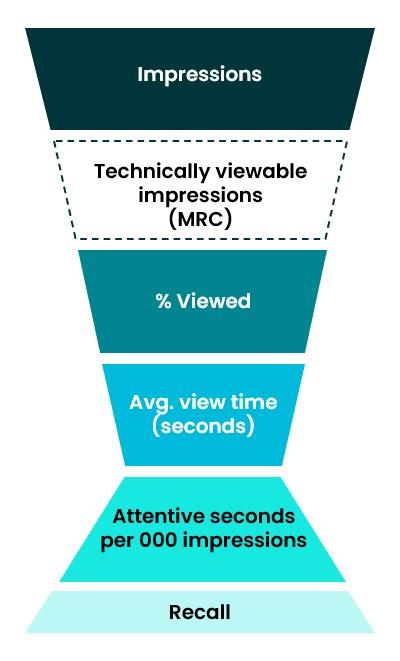](https://manual.eskimi.com/uploads/images/gallery/2024-10/I52m2qld3xRInNNO-attention-funnel.jpg)*** # IAS: Report Builder - Agency account #### **Introduction** In this article it is described regarding auto-report set up from IAS (Integral Ad Sience) vereficator. Both reports are needed in case to be able to proceed with needed optimisation of campaign. Which is crucial for reaching good campaign KPIs and troubleshoot on data descripency that usually appears due to different methodology of measurement between DSP and 3rd party verification. [Total report per campaign](https://manual.eskimi.com/link/439#bkmrk-total-campaign-repor) - this report is needed for the evaluation of campaign performance, and troubleshoot discrepancy of measured stats. Report should include campaign or/and placement as main segment split. It also should include all important KPIs and be established for period from the start till the end day of campaign. [Report per domains/apps](https://manual.eskimi.com/link/439#bkmrk-site%2Fapps-report-ste) - this report is needed for KPIs evaluation across different sites/apps and helps to optimise campaign for reaching better KPIs by excluding site and apps with lower performance. This report should include dates, campaigns and show last 30 days stats.Keep in mind that it is possible to prepare auto-report only when campaigns measured some ads. Otherwise, you will not able to select needed campaigns for your report. Therefore, Plan to prepare auto-report on the 3rd day after campaigns started, as it takes up to 48h for IAS to collect data on their side.
--- #### **Total campaign report step-by-step set up guide** 1\. First of all open your IAS account and go to "Build New Report" menu ## **[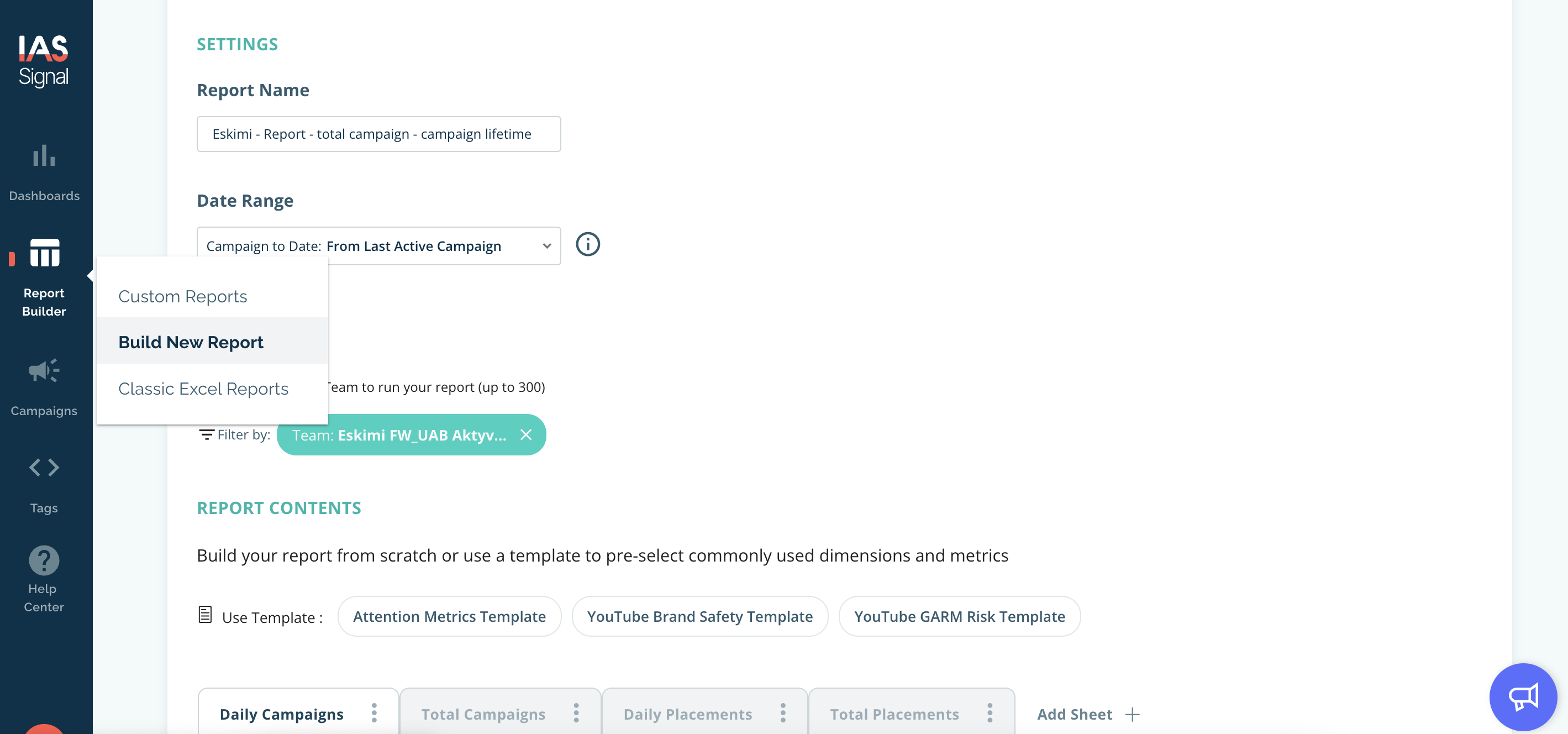](https://manual.eskimi.com/uploads/images/gallery/2023-08/aiuTTFs5HpvU3DCf-screenshot-2023-08-11-at-17-23-23.png)** 2\. In this menu you need to establish report name (keep the name clear possible for yourself and Eskimi DSP team). For "Data Range" menu select "Campaign to Date: From Last Active Campaign" and scroll down till the "Report type" section. ## **[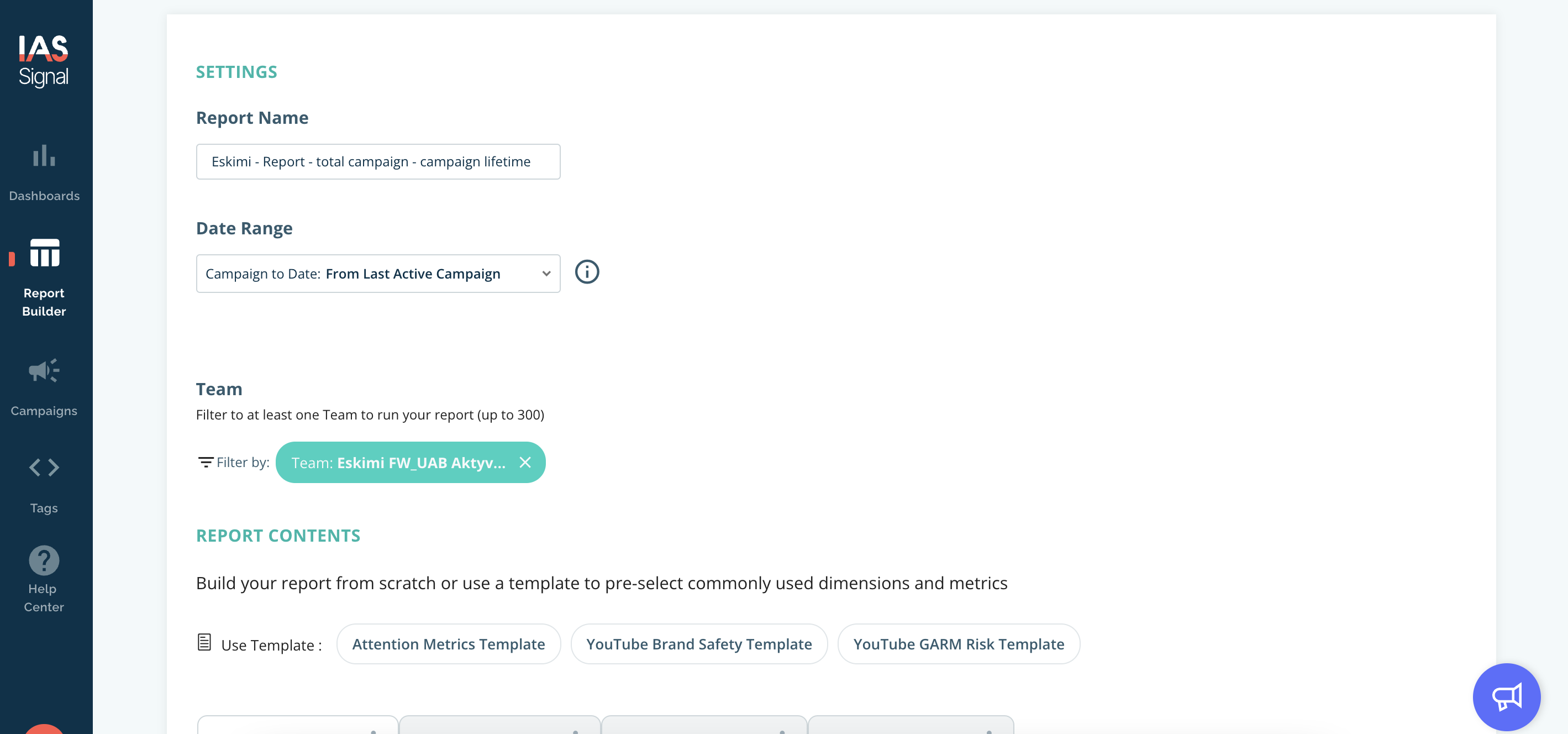](https://manual.eskimi.com/uploads/images/gallery/2023-08/o6R9Takg86GbU9rY-screenshot-2023-08-11-at-17-23-33.png)** 3\. In Report Type section you will need to create 4 different sheets as it is shown on the screen below. You can name sheets accordingly "Daily Campaigns", "Total Campaigns", "Daily Placements", "Total Placements". Each sheet will be presented in same xls file which will be generated automatically. Start with one sheet creation, select "Performance Report" and scroll down till "Dimensions" section.**Tip 1:** Create 1 sheet at first, for example "Daily Campaigns". And move to next steps. Later on the sheet might be copied so it will simplify process of creation as you will not need go from the scratch on all next steps for each separate sheet.
**Tip 2:** If you are using separate tracker per each placement, then create reports per placements as well, so it will be 4 sheets in total. However if you are measuring performance per campaign level, it would be enough to create only 2 sheets which is "Daily campaigns" and "Total campaigns"
## **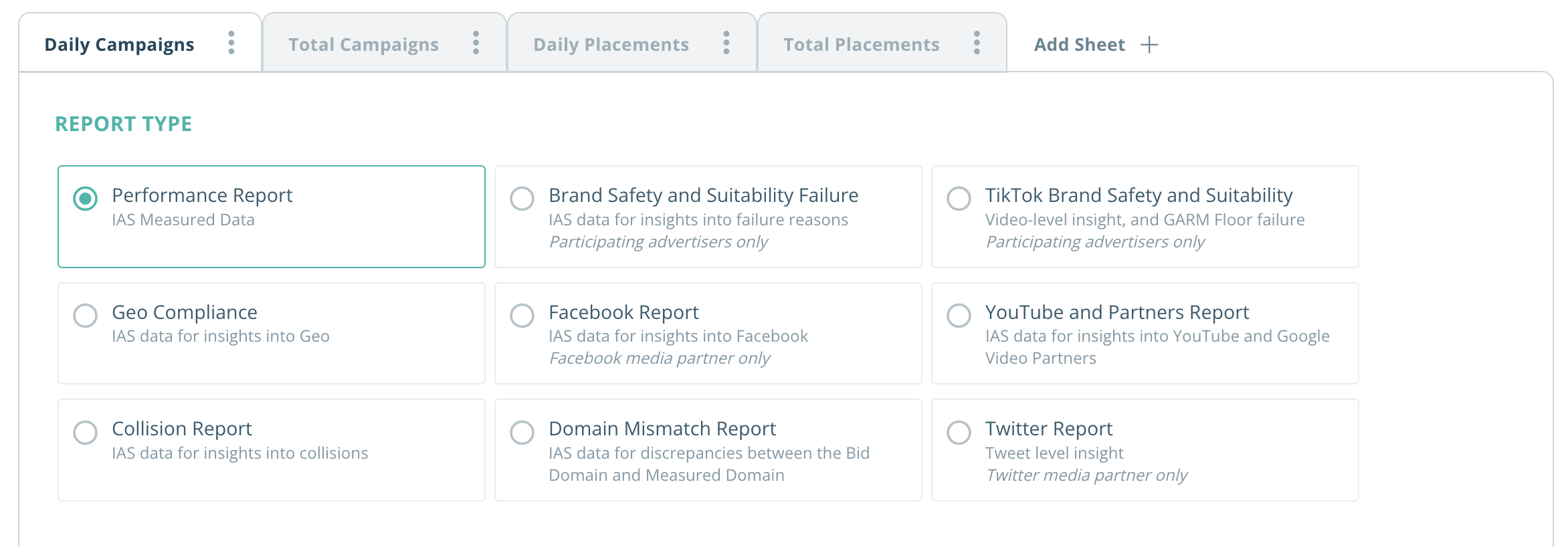** 4\. For the sheet "Daily Campaigns" for Dimensions section you need to select "Media Partners", "Campaigns", "Dates". Select dimensions in same order. Also once dimensions are selected specify media partners (it should be Eskimi), also specify campaigns (you need to select campaigns that you want to include for reporting", and as last step select "by day" for Date dimension. In this case IAS will generate report per selected campaign with daily split. Once this done scroll down till the section "Minimum Total Tracked Ads Filter". ## **[](https://manual.eskimi.com/uploads/images/gallery/2023-08/k2YQcsR1BxJuq0zF-screenshot-2023-08-11-at-17-25-42.png)** 5\. In the "minimum total tracked ads filter" section you need to select "all tracked ads". In this case all measured impressions for dimensions you selected above will be presented in the report. Once selected you need scroll down till "Metric" section ## **[](https://manual.eskimi.com/uploads/images/gallery/2023-08/Zzv8q3iWq0hTvzMx-screenshot-2023-08-11-at-17-26-01.png)** 6\. In "Metrics" section you need to enable metrics which are important to for campaign analysis. Below you can see our suggestions regarding metrics that should be selected. Please include them to any report you are creating for Eskimi team. In case you would like to know definition of the metrics, please refer to [article prepared by IAS: "Advertise Metrics Clossary"](https://helpcenter.integralads.com/topics/advertiser-agency/advertiser-metrics-glossary/advertiser-metrics-glossary)| [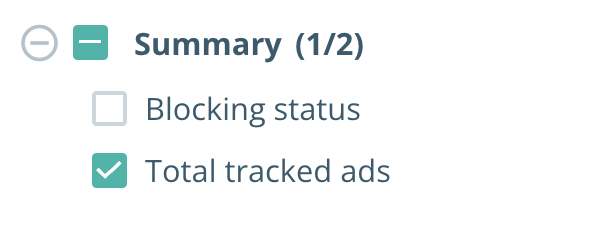](https://manual.eskimi.com/uploads/images/gallery/2023-08/OCpcynkjkRSDywKD-screenshot-2023-08-11-at-17-30-11.png) | 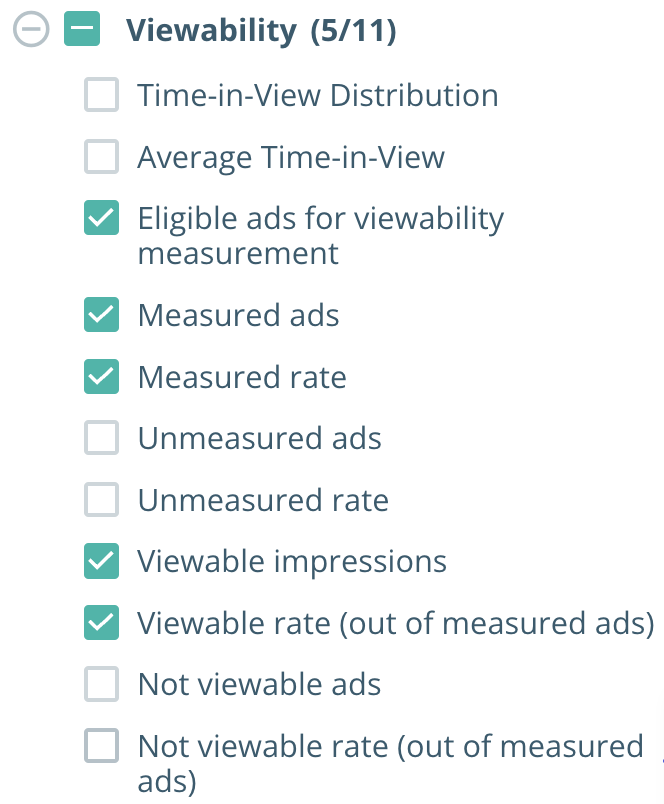 | [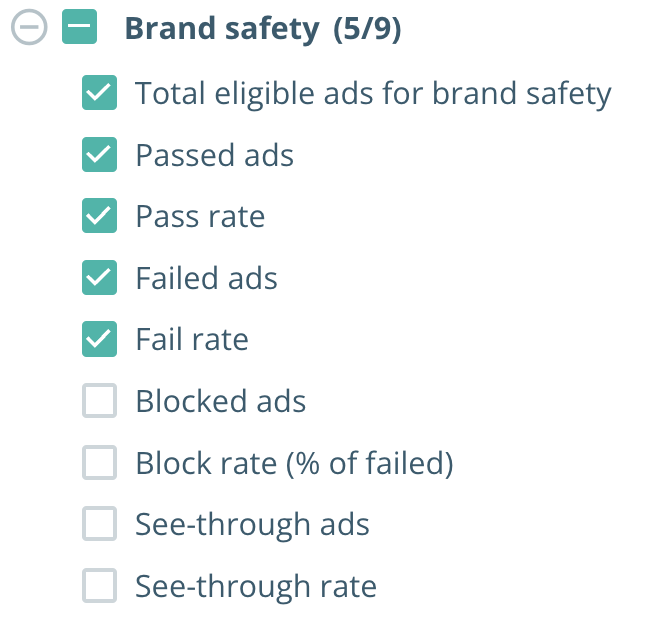](https://manual.eskimi.com/uploads/images/gallery/2023-08/oXYF5Z4KdfcDXo6M-screenshot-2023-08-11-at-17-30-34.png) |
| 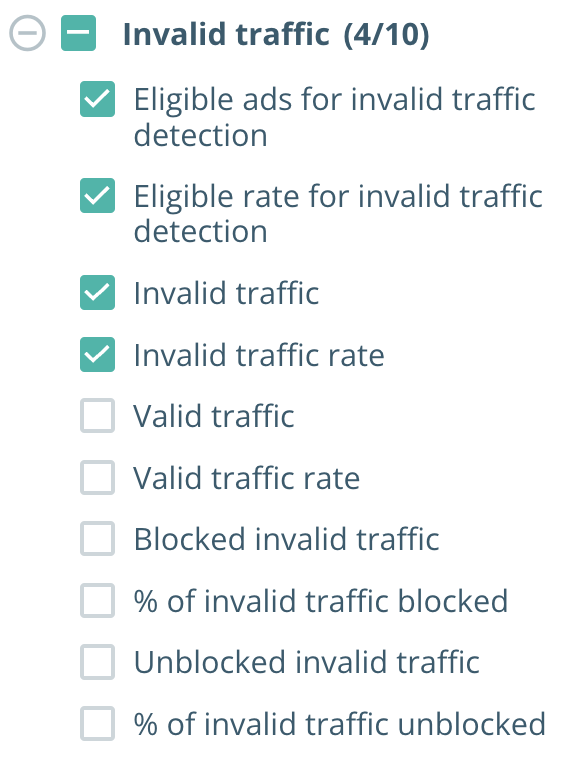 | [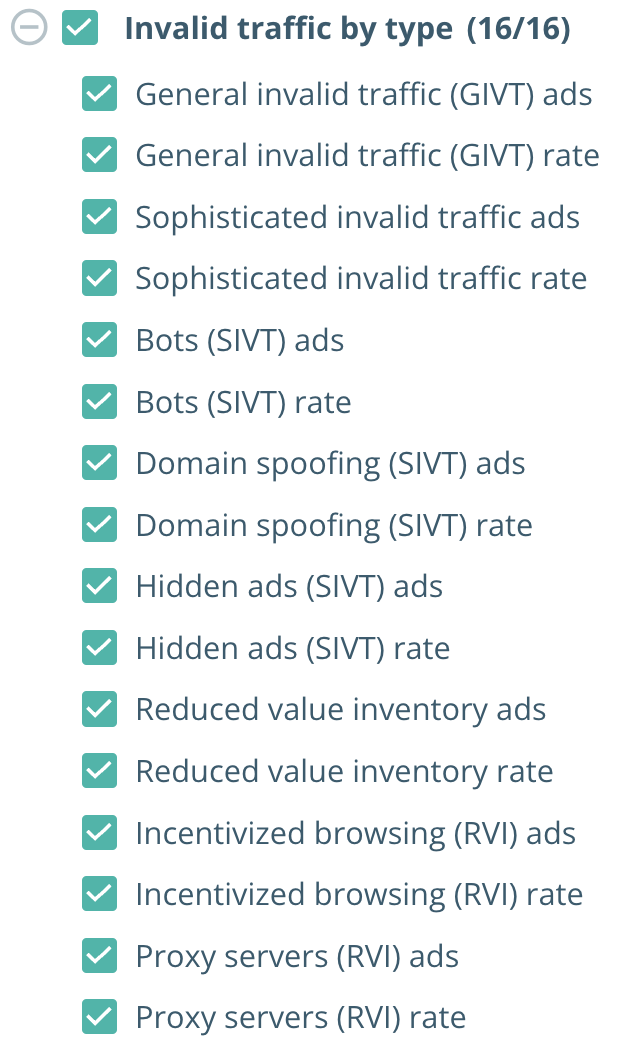](https://manual.eskimi.com/uploads/images/gallery/2023-08/zuIdcc4L7XxUN1ik-screenshot-2023-08-11-at-17-31-00.png) | |
| [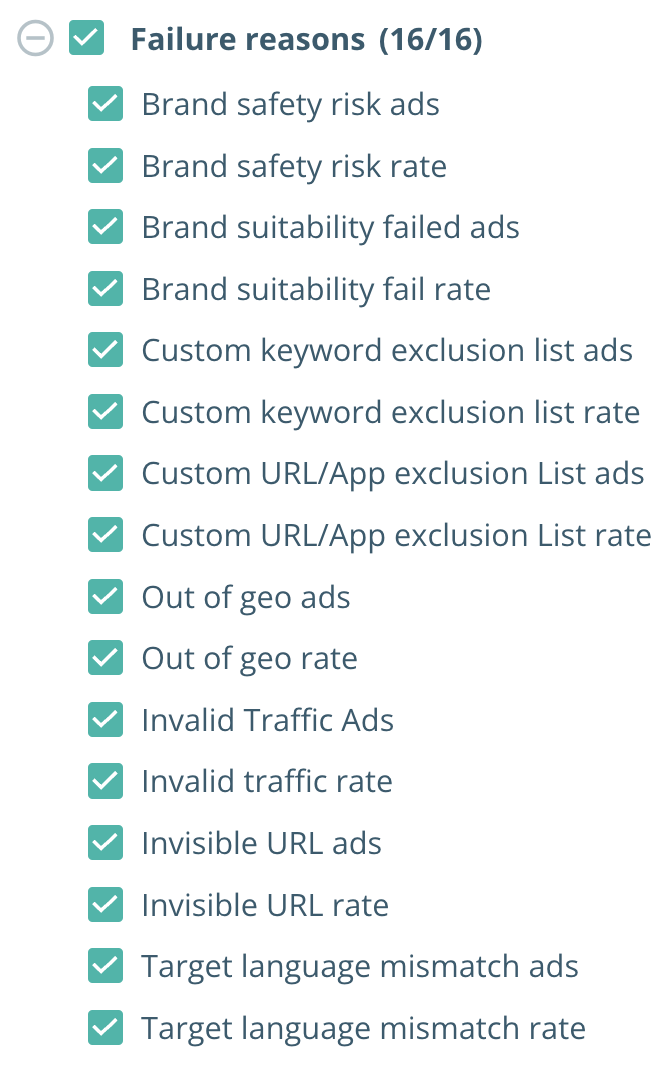](https://manual.eskimi.com/uploads/images/gallery/2023-08/rvevlQfvASNX0yDf-screenshot-2023-08-11-at-17-30-45.png) |
**Tip 1:** Create 1 sheet at first, for example "Domains". And move to next steps. Later on the sheet might be copied so it will simplify process of creation as you will not need go from the scratch on all next steps for each separate sheet.
## [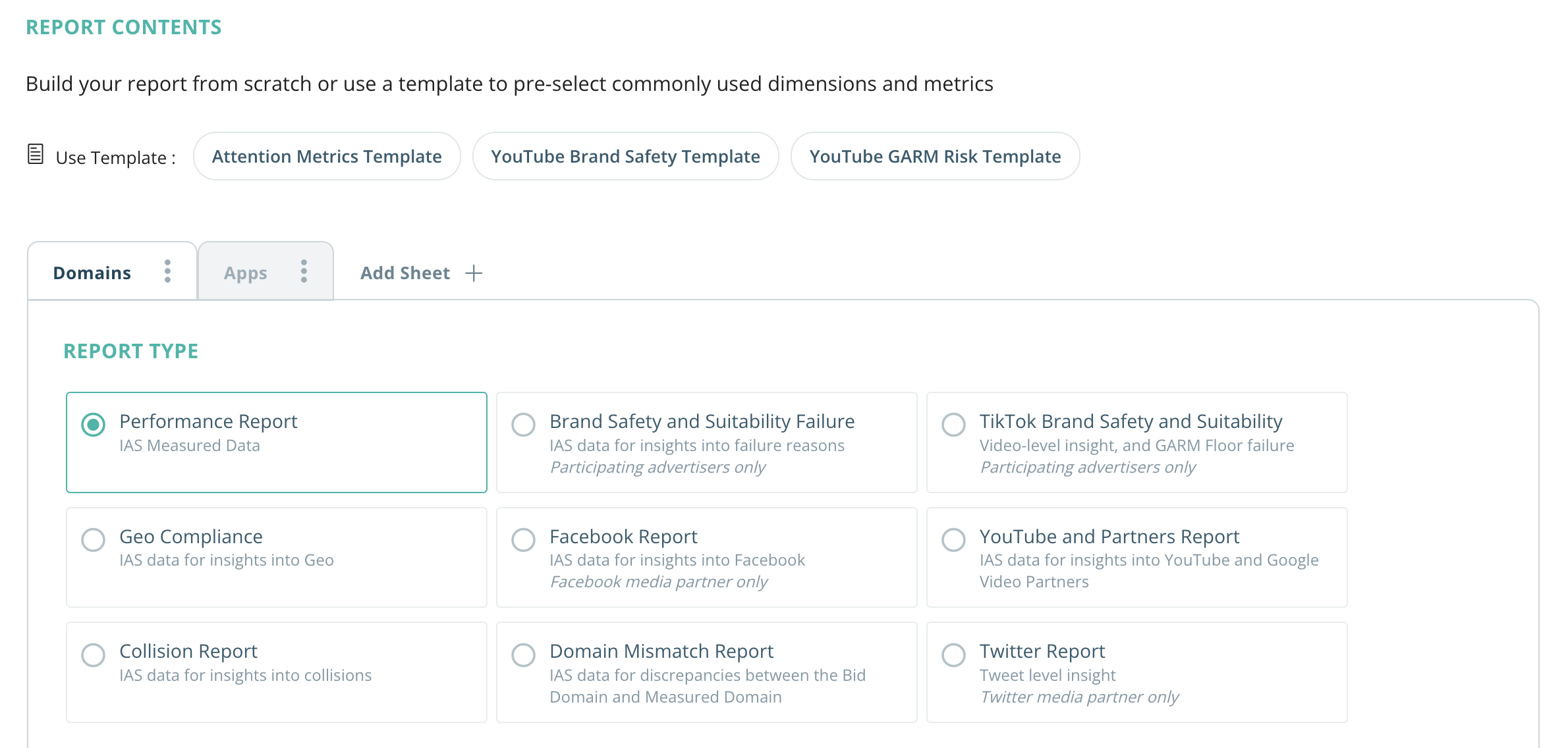](https://manual.eskimi.com/uploads/images/gallery/2023-08/TMRAS1p9HClGM4NV-screenshot-2023-08-14-at-10-36-28.png) 4\. For the sheet "Domains" for Dimensions section you need to select "Media Partners", "Campaigns", "Domains" and "Dates". Select dimensions in same order. Also once dimensions are selected specify media partners (it should be Eskimi), also specify campaigns (you need to select campaigns that you want to include for reporting", and as last step select "by day" for Date dimension. In this case IAS will generate report per domains that appeared for selected campaigns with a daily split. Once this done scroll down till the section "Minimum Total Tracked Ads Filter". ## [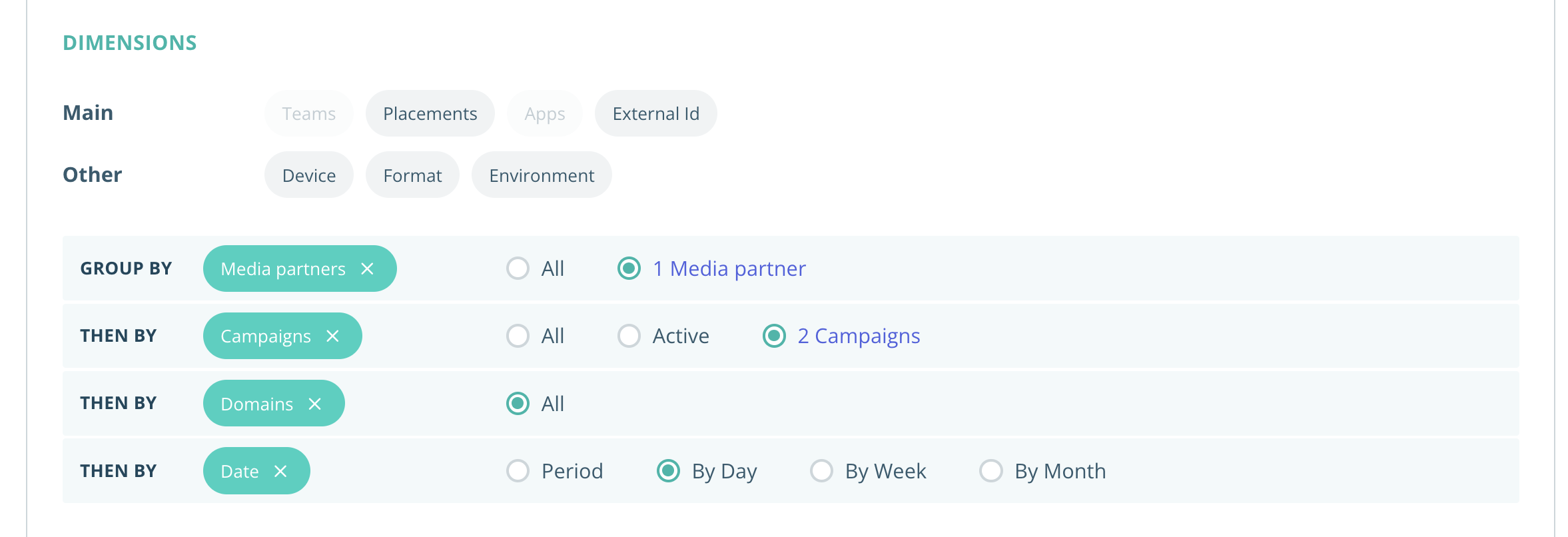](https://manual.eskimi.com/uploads/images/gallery/2023-08/z9s95mbXAvRLj08c-screenshot-2023-08-11-at-17-38-59.png) 5\. In the "minimum total tracked ads filter" section you need to select "all tracked ads". In this case all measured impressions for dimensions you selected above will be presented in the report. Once selected you need scroll down till "Metric" section ## **[](https://manual.eskimi.com/uploads/images/gallery/2023-08/Zzv8q3iWq0hTvzMx-screenshot-2023-08-11-at-17-26-01.png)** 6\. In "Metrics" section you need to enable metrics which are important to for campaign analysis. Below you can see our suggestions regarding metrics that should be selected. Please include them to any report you are creating for Eskimi team. In case you would like to know definition of the metrics, please refer to [article prepared by IAS: "Advertise Metrics Clossary"](https://helpcenter.integralads.com/topics/advertiser-agency/advertiser-metrics-glossary/advertiser-metrics-glossary)| [](https://manual.eskimi.com/uploads/images/gallery/2023-08/OCpcynkjkRSDywKD-screenshot-2023-08-11-at-17-30-11.png) |  | [](https://manual.eskimi.com/uploads/images/gallery/2023-08/oXYF5Z4KdfcDXo6M-screenshot-2023-08-11-at-17-30-34.png) |
|  | [](https://manual.eskimi.com/uploads/images/gallery/2023-08/zuIdcc4L7XxUN1ik-screenshot-2023-08-11-at-17-31-00.png) | |
| [](https://manual.eskimi.com/uploads/images/gallery/2023-08/rvevlQfvASNX0yDf-screenshot-2023-08-11-at-17-30-45.png) |
| **IAS Solution** | **Explanation** |
| Blocking | Display tags with blocking. Reures JS |
| Monitoring | Display tags without blocking. Can be JS or image |
not an impression pixel
``` https://pixel.adsafeprotected.com/?anId=931059&advId=Eskimi&campId={campaign_id_enc}&pubId= {site_domain_enc}{app_bundle_enc}&chanId={creative_id_enc}&placementId={placement_id} ```correct impression pixel
| **IAS Solution** | **Explanation** | **Requirements** |
| Multimedia Tag Monitoring | Video tracking tag that will work across desktop, CTV, mobile & in-app. Can measure viewability, set to not block | Requires a VPAID player/publisher support & 3rd party ad serving |
| Multimedia Tag Blocking | Video tracking tag that will work across desktop, CTV, mobile & in-app. Can measure viewability, set to block | Requires a VPAID player/publisher support & 3rd party ad serving |
| Unified Video Pixel | Video tracking tag that will work across desktop, CTV, mobile & in-app. Cannot measure viewability or block | Requires a VAST player & 3rd party ad serving |